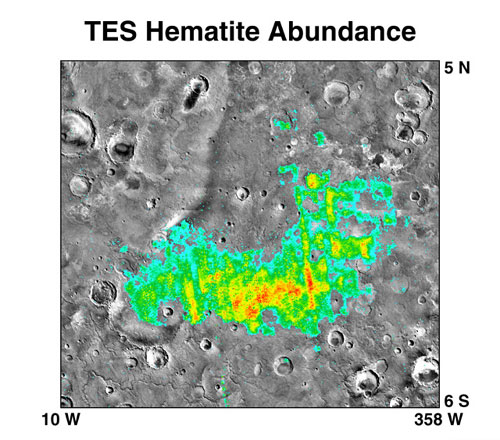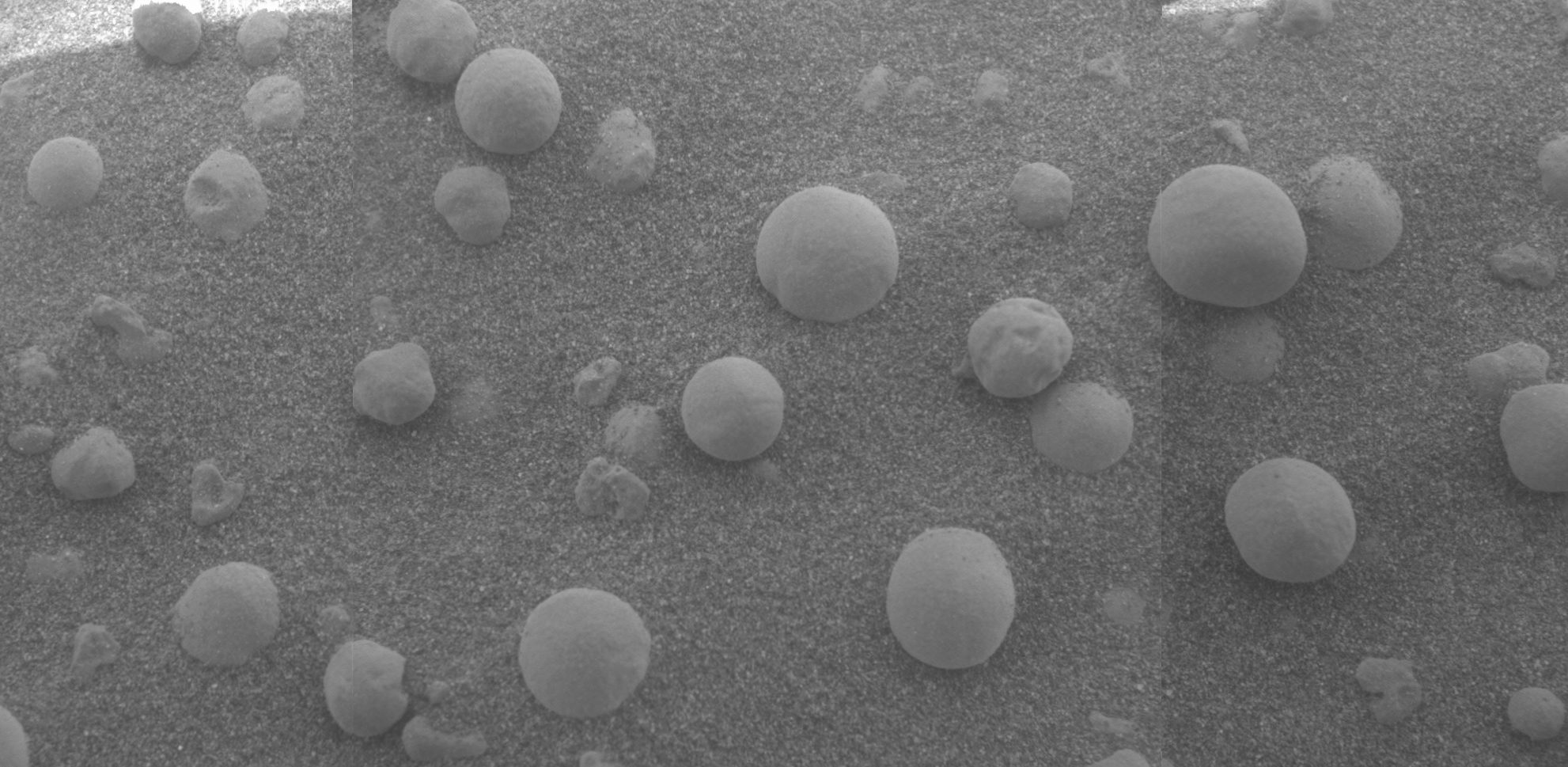|
Thermal Emission Spectrometer
The Thermal Emission Spectrometer (TES) was an instrument on board Mars Global Surveyor. TES collected two types of data, hyperspectral thermal infrared data from 6 to 50 micrometres (μm) and bolometric visible-near infrared (0.3 to 2.9 μm) measurements. TES had six detectors arranged in a 2x3 array, and each detector had a field of view of approximately 3 × 6 km on the surface of Mars. The TES instrument used the natural harmonic vibrations of the chemical bonds in materials to determine the composition of gases, liquids, and solids. TES identified a large (30,000 square-kilometer) area that contained the mineral olivine. Olivine was found in the Nili Fossae formation. It is thought that the ancient impact that created the Isidis basin resulted in faults that exposed the olivine. Olivine is present in many mafic volcanic rocks. In the presence of water it weathers into minerals such as goethite, chlorite, smectite, maghemite, and hematite. Olivine was also disc ... [...More Info...] [...Related Items...] OR: [Wikipedia] [Google] [Baidu] |
Mars Observer - MGSTESpic Sm
Mars is the fourth planet from the Sun. It is also known as the "Red Planet", because of its orange-red appearance. Mars is a desert-like rocky planet with a tenuous carbon dioxide () atmosphere. At the average surface level the atmospheric pressure is a few thousandths of Earth's, atmospheric temperature ranges from and cosmic radiation is high. Mars retains some water, in the ground as well as thinly in the atmosphere, forming cirrus clouds, frost, larger polar regions of permafrost and ice caps (with seasonal snow), but no liquid surface water. Its surface gravity is roughly a third of Earth's or double that of the Moon. It is half as wide as Earth or twice the Moon, with a diameter of , and has a surface area the size of all the dry land of Earth. Fine dust is prevalent across the surface and the atmosphere, being picked up and spread at the low Martian gravity even by the weak wind of the tenuous atmosphere. The terrain of Mars roughly follows a north-south divid ... [...More Info...] [...Related Items...] OR: [Wikipedia] [Google] [Baidu] |
Maghemite
Maghemite (Fe2O3, γ-Fe2O3) is a member of the family of iron oxides. It has the same formula as hematite, but the same spinel ferrite structure as magnetite () and is also ferrimagnetic. It is sometimes spelled as "maghaemite". ''Maghemite'' can be considered as an Fe(II)-deficient magnetite with formula \left(\ce\right)_A\left ce\rightB\ce where \square represents a vacancy, A indicates tetrahedral and B octahedral positioning. Occurrence Maghemite forms by weathering or low-temperature oxidation of spinels containing iron(II) such as magnetite or titanomagnetite. Maghemite can also form through dehydration and transformation of certain iron oxyhydroxide minerals, such as lepidocrocite and ferrihydrite. It occurs as widespread brown or yellow pigment in terrestrial sediments and soils. It is associated with magnetite, ilmenite, anatase, pyrite, marcasite, lepidocrocite and goethite. It is known to also form in areas that have been subjected to bushfires (particularly ... [...More Info...] [...Related Items...] OR: [Wikipedia] [Google] [Baidu] |
Spectrometers
A spectrometer () is a scientific instrument used to separate and measure Spectrum, spectral components of a physical phenomenon. Spectrometer is a broad term often used to describe instruments that measure a continuous variable of a phenomenon where the spectral components are somehow mixed. In visible light a spectrometer can separate white light and measure individual narrow bands of color, called a spectrum. A mass spectrometer measures the spectrum of the masses of the atoms or molecules present in a gas. The first spectrometers were used to split light into an array of separate colors. Spectrometers were History_of_spectroscopy, developed in early studies of physics, astronomy, and chemistry. The capability of spectroscopy to determine Analytical_chemistry#Spectroscopy, chemical composition drove its advancement and continues to be one of its primary uses. Spectrometers are used in Astronomical spectroscopy, astronomy to analyze the chemical composition of Astronomical_spe ... [...More Info...] [...Related Items...] OR: [Wikipedia] [Google] [Baidu] |
Phil Christensen
Philip Russel Christensen (born 1953) is a geologist whose research interests focus on the composition, physical properties, processes, and morphology of planetary surfaces, with an emphasis on Mars and the Earth. He is currently a Regents' Professor and the Ed and Helen Korrick Professor of Geological Sciences at Arizona State University (ASU). Education Christensen earned his B.S. degree in Geology from the University of California, Los Angeles in 1976. He earned his M.S. in 1978 and his Ph.D. in 1981 in Geophysics and Space physics, both from the University of California, Los Angeles. Career Along with serving on the faculty of the Department of Geology at Arizona State University since 1981, Christensen is the principal investigator for the Mars Global Surveyor Thermal Emission Spectrometer (TES), the Mars Odyssey THEMIS, the Europa Clipper Europa Thermal Emission Imaging System and the Lucy Thermal Emission Spectrometer instruments, as well as a co-investigator for the Ma ... [...More Info...] [...Related Items...] OR: [Wikipedia] [Google] [Baidu] |
Thermal Infrared Spectroscopy
Thermal infrared spectroscopy (TIR spectroscopy) is the subset of infrared spectroscopy that deals with radiation emitted in the infrared part of the electromagnetic spectrum. The emitted infrared radiation, though similar to blackbody radiation, is different in that the radiation is banded at characteristic vibrations in the material. The method measures the thermal infrared radiation emitted (as opposed to being transmitted or reflected) from a volume or surface. This method is commonly used to identify the composition of surface by analyzing its spectrum and comparing it to previously measured materials. It is particularly suited to airborne and spaceborne applications. Thermal infrared spectrometers Airborne *HyTES: the Hyperspectral Thermal Emission Spectrometer operated by JPL and flown on a Twin Otter or ER2 aircraft *TIMS: the Thermal Infrared Multispectral Scanner, a multispectral radiometer flown on C-130, ER-2, and the Stennis Learjet aircraft. *SEBASS: a hyperspectr ... [...More Info...] [...Related Items...] OR: [Wikipedia] [Google] [Baidu] |
Thermal Emission Imaging System
The Thermal Emission Imaging System (THEMIS) is a camera on board the 2001 Mars Odyssey orbiter. It images Mars in the visible and infrared parts of the electromagnetic spectrum in order to determine the thermal properties of the surface and to refine the distribution of minerals on the surface of Mars as determined by the Thermal Emission Spectrometer (TES). Additionally, it helps scientists to understand how the mineralogy of Mars relates to its landforms, and it can be used to search for thermal hotspots in the Martian subsurface. THEMIS is managed from the Mars Space Flight Facility at Arizona State University and was built by the Santa Barbara Remote Sensing division of Raytheon, Raytheon Technologies Corporation, an American multinational corporation, multinational list of conglomerates, conglomerate headquartered in Waltham, Massachusetts. The instrument is named after Themis, the goddess of justice in ancient Greek mythology. Infrared camera THEMIS detects thermal ... [...More Info...] [...Related Items...] OR: [Wikipedia] [Google] [Baidu] |
Meteorites
A meteorite is a rock that originated in outer space and has fallen to the surface of a planet or moon. When the original object enters the atmosphere, various factors such as friction, pressure, and chemical interactions with the atmospheric gases cause it to heat up and radiate energy. It then becomes a meteor and forms a fireball, also known as a shooting star; astronomers call the brightest examples " bolides". Once it settles on the larger body's surface, the meteor becomes a meteorite. Meteorites vary greatly in size. For geologists, a bolide is a meteorite large enough to create an impact crater. Meteorites that are recovered after being observed as they transit the atmosphere and impact Earth are called meteorite falls. All others are known as meteorite finds. Meteorites have traditionally been divided into three broad categories: stony meteorites that are rocks, mainly composed of silicate minerals; iron meteorites that are largely composed of ferronickel; and s ... [...More Info...] [...Related Items...] OR: [Wikipedia] [Google] [Baidu] |
Chassigny (meteorite)
Chassigny is a Martian meteorite which fell on October 3, 1815, at approximately 8:00 am, in Chassigny, north-eastern France.Pistollet (1816) The circumstances of the Chassigny meteorite shower. Ann. Chim. Phys. (Paris) v. 1, pg 45-48. Chassigny is the meteorite for which the chassignites are named and gives rise to the "C" in the name of the SNC group of meteorites. Chassigny is an olivine cumulate rock (dunite). It consists almost entirely of olivine with intercumulus pyroxene, feldspar, and oxides. It was the only known chassignite until NWA2737 was found in the Moroccan Sahara in northwest Africa. Chassigny is particularly important because, unlike most SNCs, its noble gas composition differs from that in the current Martian atmosphere. These differences are presumably due to its cumulate (mantle-derived) nature. [...More Info...] [...Related Items...] OR: [Wikipedia] [Google] [Baidu] |
Nakhlite
Nakhlites are a group of Martian meteorites, named after the first one, Nakhla meteorite. Nakhlites are igneous rocks that are rich in augite and were formed from basaltic magma about 1.3 billion years ago. They contain augite and olivine crystals. Their crystallization ages, compared to a crater count chronology of different regions on Mars, suggest the nakhlites formed on the large volcanic construct of either Tharsis, Elysium, or Syrtis Major Planum.Treiman, A.H."The nakhlite meteorites: Augite-rich igneous rocks from Mars"- (PDF) Chemie der Erde 65, p. 203-270, (2005). URL accessed July 30, 2011. History A 2017 study dated them to at least four different eruptions from 1416 ± 7 Ma to 1322 ± 10 Ma. It has been shown that the nakhlites were suffused with liquid water around 620 million years ago and that they were ejected from Mars around 10.75 million years ago by an asteroid impact. They fell to Earth within the last 10,000 years. Possible source crater in El ... [...More Info...] [...Related Items...] OR: [Wikipedia] [Google] [Baidu] |
Shergottite
A Martian meteorite is a rock that formed on Mars, was ejected from the planet by an impact event, and traversed interplanetary space before landing on Earth as a meteorite. , 277 meteorites had been classified as Martian, less than half a percent of the 72,000 meteorites that have been classified. The largest complete, uncut Martian meteorite, Taoudenni 002, was recovered in Mali in early 2021. It weighs 14.5 kilograms (32 pounds) and is on display at the Maine Mineral and Gem Museum. There are three groups of Martian meteorite: shergottites, nakhlites and chassignites, collectively known as SNC meteorites. Several other Martian meteorites are ungrouped. These meteorites are interpreted as Martian because they have elemental and isotopic compositions that are similar to rocks and atmospheric gases on Mars, which have been measured by orbiting spacecraft, surface landers and rovers. The term does not include meteorites found on Mars, such as Heat Shield Rock. Histo ... [...More Info...] [...Related Items...] OR: [Wikipedia] [Google] [Baidu] |
Hematite
Hematite (), also spelled as haematite, is a common iron oxide compound with the formula, Fe2O3 and is widely found in rocks and soils. Hematite crystals belong to the rhombohedral lattice system which is designated the alpha polymorph of . It has the same crystal structure as corundum () and ilmenite (). With this it forms a complete solid solution at temperatures above . Hematite occurs naturally in black to steel or silver-gray, brown to reddish-brown, or red colors. It is mined as an important ore mineral of iron. It is electrically conductive. Hematite varieties include ''kidney ore'', ''martite'' ( pseudomorphs after magnetite), ''iron rose'' and ''specularite'' ( specular hematite). While these forms vary, they all have a rust-red streak. Hematite is not only harder than pure iron, but also much more brittle. The term ''kidney ore'' may be broadly used to describe botryoidal, mammillary, or reniform hematite. Maghemite is a polymorph of hematite (γ-) with the ... [...More Info...] [...Related Items...] OR: [Wikipedia] [Google] [Baidu] |






